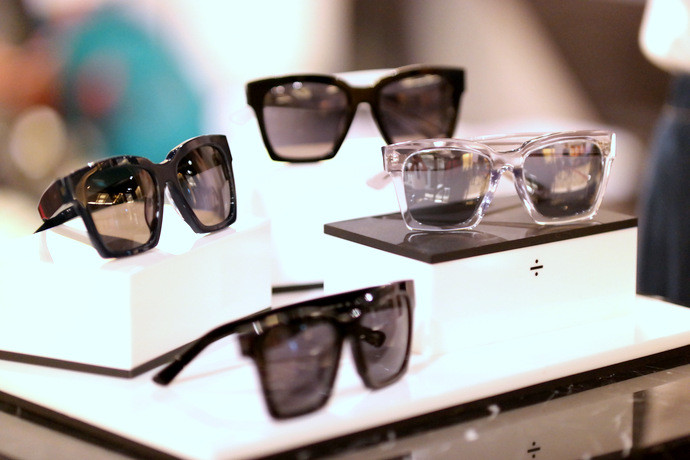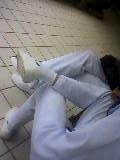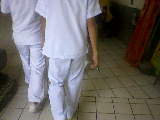NARRATIVE
First things first.
I told myself I didn't know what to do.
The day before was still a relapse of memory - shocking and
reverberating. I called Paul Gines to assure if they were on-duty for
12 hours the following day, and he said yes adding that Mark Balonquita
was his partner (but, didn't say Brian Santos was too). That does the
conversation. Period.
The thing is, I called at the spur of the moment. I called on a whim. Not planning anything ahead or whatsoever.
And the next day, I was sure the only thing I brought along sans the
immunology lectures and applications/lab skills was myself clad in a
head-turning OJT uniform at 6:30 am on October 16, 2010 in the Veterans
Regional Hospital, Bayombong, Nueva Vizcaya.
The idea was not being
totally stupid. I was there as "an observer" - where I should have been
really a part of it supposedly - because I wanted to learn, I needed to
experience, I had to feed my mind, I bent beyond certain circumstances.
Simply put, I was ignorant at the same time innocent. I was "more or
less an observer".
Still...
Upon entering the lab area for
examination, I thought I saw myself in retrogression. This was
unspeakably familiar. The time was 7 am. Being the newcomer, I was
frequently asked by the staff of chemists, medical technologists, lab
technicians, doctors, et al. As for courtesy and authority-awareness
that were two things that shouldn't be forgotten during OJTs, I had to
remind myself about it.
Thereafter, anyway, I tailed the three
masculados into the stock room/ small lobby to leave our bags. I managed
to watch them, with one of the staff - a Ma'am, keenly prepare the desk
at the out-patient department (OPD) area of the lab. The basic
paraphernalia were Terumo needles ranging from 20, 23, to 25 gauges,
syringes of 3cc, 5cc, and 10cc, compartmentalized cottonballs (with and
without alcohol), micropore, scissors, small test tubes (generally used
for 2 purposes: (1) blood chemistry analysis [red-capped] and, (2)
complete blood count-actual platelet count / CBC-APC analysis
[blue-capped] ), Kahn tubes, to-fill-in and filled-in lab test request
papers, trashbins (non-bio and hazardous), and what struck me most was
the madeshift tourniquet - a spared surgical glove [shouldn't the
hospital have enough supply for it?]
The first patient was an old
man who was venipunctured in the arm by Mr. Gines. The latter performed
the plebotomy quite easily and swiftly in less than a half insertion at
approximately 25° angle with the bevel faced up. I mentally noted that.
Then, the old man was asked to return at 1 pm that same day. After
collecting the blood, I took note on how he removed the needle off the
syringe pulling it and not turning, transferred the blood diagonally
into the blue-capped tube filled up to the black marked line and labeled
it with the patient's name and the test requested. I had to back-off
sooner since the space required a very very limited number of people.
Meanwhile, Mr. Balonquita had his first patient at the emergency room
(ER) area too and didn't bother for our assistance.
At circa 8 am,
the blood bank opened. Mr. Balonquita appointed himself at the ER. Mr.
Gines gave his stead in the bloodbank to me, and hence, busied himself
at the OPD where patients started to arrive and pile themselves. Lastly,
Brian had to take care of me in our designated area.
This was unspeakably familiar.
The picture depicted in the bloodbank room as soon as we entered was like this:
The percentage of the patients waiting in the plastic benches comprised
mostly of babies. Doctora "Anne" was busy with the microscope while the
Head Medtech was checking the serum bags in the refrigerator. Ma'am
Mads, called for the first patient and the mother. And there, on the
background the two of us stood. As soon as Ma'am Mads took the baby and
the blood testing sheet, instinct told me to follow her. I held the baby
in place at the bed hushing, noticed how Ma'am took off the baby's
booties, and looked at the medium plastic tray that contained the needed
paraphernalia. She venipunctured the base of the foot with a Western
tennis-like grip on the sole, tightened until pea-sized blood dropped
blotching the four circles in the blood testing sheet. Then, after she
covered the pricked part with cotton and micropore, I initiated dressing
the baby. Seeing how I held the baby with both of my hands, Ma'am Mads
was seemingly in awe finally asking how I knew the proper handling of a
baby. Thanks for the couple of years I was exposed in the medical field.
Now, that's where things started to fall in place.
After that, I
was asked to take blood pressures too. However, Dra. "Anne" said she'd
be the one to handle it since there were still prerequisites. I
extensively assisted in baby patients, was even queried whether I liked
to try venipuncture. I did. But, I was too vulnerable in handling babies
in fear of their fragility. That's why I only performed twice, wherein
one of those I only squeezed the blood into squirts. I really better
practice more so that there would be no repeat of the said incident.
The first adult patient I took care of for phlebotomy made me really
nervous. I admit I did fail on that one. Failed in terms of the duration
of needle exposure right after the extraction and the obvious shaking
of my hand. Yet, I did apply what I have observed earlier from my
classmates. After taking the syringe from my hand, Head Medtech and
Ma'am Mads called my attention, carefully taught me the proper mechanics
with the next patient: the fingers properly placed, the thumb and index
finger are lightly but firmly placed on the head of syringe (not
needle) on both sides, the middle finger supporting the "pull" of the
syringe. The insertion is made half-way into the vein, making sure the
needle is almost inside to prevent spilling of the blood; meanwhile,
upon entering the needle, the bevel - faced up - was twisted slowly
without making the patient notice it until the bevel faced the side wall
of the vein (this is to prevent the walls to collapse, that's how I
remembered). A cotton is placed before the release of tourniquet and the
needle. The cap is placed with the needle horizontally to avoid
spillage. The whole proceeding is very very and/or somehow different
from what I have observed form others. This is only one part that I
wanted to write in detail as a sample of what we actually did. Sooner, I
almost did fine.
Mr. Santos and I were next called to regard
attentively the two types of bloodtyping, one of which they refer to as
the "Golden Bloodtyping", which is of course the universally used:
Anti-serum A, Anti-serum B, and Rh testing placed on slides. A few
briefing and recaps (where I got sleazy in putting my mind into engine -
a big mistake) were conducted. Later on, we performed and even wrote on
the sheets of the patients the results. What was also important were to
drop the reagents away from the other reagents and a tad far in terms
of height, to have it in equal ratio with the blood sample, and
determine and verify the amalgamation twice to thrice, direct and under
the light. As the two types have different methods, their output
determination are also opposite, but almost the same in output. Almost
because there may have a difference in the Rh-typing.
At around
10 am, we were summoned back for the cross-matching. While waiting, I
assumed assistance where: Before placing the blood sample on the
centrifuge, a check for possible presence of hepatitis and AIDS was
conducted. Anyway, the manual preparation of saline solution wasn't
anymore necessary since it has its own modernized/commercialized version
already. Hence, we proceeded to the measurement, dropping, and mixture
of the blood with the saline solution. Each on a very precise manner. A
5% approximation of the solution into a Kahn tube is equivalent to __
micropint. It was always noted that whenever bottles are nearly empty,
it should never become fully-emptied due to the presence of residues.
So, jumping to the final process of cross-matching, it was done 15
minute each machine accurately timed.
(After we atelunch, we headed back to the OPD waiting area. Talked about the upcoming NBA finals, whose side is who, which team is stronger, and the different historical moments of the game's stars. Oh yeah, I took part.)
(It was already nearing 1 o'clock, we strutted towards the lab.)
As soon as lunchbreak was
over, my hands busied itself whether on the blood blank, scribbling a
tabulated data in the logbooks, or at the ER assisting Mr. Balonquita.
During the times when I was the only one at the the blood bank, I was
luckily coached by Dra. in a more detailed one in the various situations
within the area. From the refrigerated bags of bloods and sera to its
expiration and to its proper handling when transported, to hepatitis and
AIDS determination, to the other tests conducted to the patients, to
the machines and its different uses and technicalities. All in a
step-by-step fashion. Whenever I started to become quaint and was piqued
to the smallest of intrigues, she gladly and tenderly gave answers,
expanded it, and extended beyond.
When the clock strIked 6, we had a
terse break and we were invited for some cake and coke at the lobby.
They were really friendly. And we were "timid".
We waited, and tended, trifled, and yet remained attentive until it was time for us to check-out.
INSIGHT
There are always multifarious ways of addressing, yes addressing
insights according to the beneficiary. One, the "first person" - I. The
other is the "others" whomever this may concern.
First Person.
They
say never start anything, a write-up for that matter with a sorry; but,
I have to overlook that. I am not sorry for myself, in-fact, I am quite
grateful that the entire event happened as it is otherwise I wouldn't
be noticing my flaws. Even though I never got the chance to continue my
remaining 12 hours and listened to worthless predicaments, it turned
out that I already acquired a handful and it was just right since there
were circumstances following. The only regret I had was the masculados
never gave me the chance to perform four other procedures even if I was
already instructed and stuck me to only two. Still, it's great that I
was lucky enough to adjoin my knowledge of the past and the present.
To whomever this may concern.
I
do think, deem, and not just surmise, that in order for one party to be
accomplished, the other should cooperate no matter how large,
domineering, absurd, or complex the difference is. Really. Proper
mechanics should be followed. Proper conduct should be observed. Proper
disposal and management of arguments, ideas, and facts should always be
remembered.
Shouldn't the students be more practical, conspicuous,
alert, yielding to what is true, and grab the opportunities they are
given in experiencing and most especially in caring for the patients
(well, they know for what reasons)? Shouldn't there be an "ironed" and
made-well known to the public set of rules and regulations inside the
hospital to prevent misunderstandings with the patients? Shouldn't there
be a wider scope of looking into things, I am referring to the patients
to avoid, er, unpleasant incidences? Shouldn't there be an official and
universal teaching for the students to not be confused or if not at
least a bigger conjunction among the ideas? And, shouldn't the
government be more aware and capable of figuring out what is what in the
real situation inside the hospital?
After all, these only point to one consequential matter: saving lives.
It is not to be overlooked, however, that there are lots of people
within the hospital who are earnest with their jobs just to fulfill
their responsibilities, and are more than willing enough to pass what
they have to the next generation. Without them, we, I wouldn't know
anything.
Last but not the least...
The most significant part that I learned... Never ever make even the least mistake when life is at stake.
Filed under kyooiku kankei no | hn. your pen's toilet



